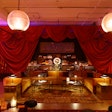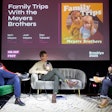
Sometime around the turn of the millennium, gifting suites were a novelty all by themselves. But the marketplace has continually reinvented itself, contending with the likes of a recession, new I.R.S. rules, and media fatigue over the same old thing. Here’s a look at how the landscape of swag suites looks right now.
It’s a crowded marketplace
Swag suites are de rigueur around award shows, and it’s not easy to get noticed—or to generate the return on investment that participating brands need to see. “Because it is commonplace now, with the multitude of opportunities out there, it's really about weeding through the noise to find the right opportunity,” says Backstage Creations president and founder Karen Wood. “There needs to be a significant number of key celebrity photos taken with the brand that can run in major magazines, not just a lot of photos taken with [lower-tier] celebrities who may be unknown or not known enough to have editors care to run them. If you are sold into an event based on a certain expectation, and it doesn't live up to them, it could sour a brand to celebrity gifting completely.”
Britt Johnson of Mediaplacement, which presents the Emmys and Golden Globes “Luxury Lounge” suites with HBO, agrees: “It’s harder for us to reach out to brands because to some degree it’s been a little bit of a wild west out there [with other event organizers]. We manage expectations. We tell them who they are going to interact with.”
Successful suites are smaller
If the goal in earlier years may have been to create a gifting bonanza with as many freebies as possible, many that find success have a different approach these days. “We keep it exclusive, intimate—we don’t have more than 15 brands max, so each brand gets to spend time with the celebrity," Johnson says.
It’s about relationship building
Whereas a goal in the early days of gifting suites might have been to simply score pictures with celebs, now it’s about longer-term goals. “We meet with our sponsors beforehand and say, ‘Keep away from trying to hold up bags with celebs, because no one’s going to use that [shot],” Johnson says. “It's really not about what celebs are getting—it’s really more of a marketing summit.” He described watching an ambassador relationship evolve between Neutrogena and Kristen Bell, who got on the brand’s radar at a Mediaplacement gifting event.
Charity tie-ins help—if they’re sincere
Some suites advertise a donation to a particular charity on behalf of the event, or offer some other philanthropic tie-in. And some organizers say this is key: "Celebrities are more apt to attend gift lounges that they know not only have good products but have a charitable component,” says GBK founder and C.E.O. Gavin Keilly. “This is very important, as many celebrities are looking at ways to give back and make a difference.”
Johnson doesn't necessarily take the same approach: "We never really wanted to just put a charity involved just to try to sweeten the storyline. [A gift suite] is a very efficient way of marketing, and it’s a marketing event. If we’re not going to raise a ton of awareness or money [for charity], there’s no point [in lip service].”
Technicalities matter
The days of the suite free-for-all are over, and organizers feel the need to be more buttoned up about technicalities and legalities in the new age. “The latest changes for 2014 are that most of the major award shows are asking their legal teams to contact entities that use their show name, logo, statue, and other trademarked items. It's gotten pretty heated,” says Wood, who hosts many award shows’ officially sanctioned backstage suites. “Brands will pay millions of dollars to sponsor the award shows and when ambush companies use the show name without permission, it diminishes the exposure the legit brands would garner.”
Media decision makers want more interesting photo ops
An ordinary photo of a celeb holding up a product or shopping bag holds dwindling interest for seen-it-all photographers and editors. So suite organizers are looking for ways to produce events that offer built-in photo ops with tons of visual interest. “We create custom activations for brands to help garner just the right photograph,” Wood says. “At Teen Choice, we created a classroom display, complete with desks and a blackboard with the Office Depot logo chalked in graffiti. One Direction posed with notebooks and the photo went viral. It's doubtful the same shot would have captured photo editors' attention if it had just had the boys holding notebooks.”
In another example, GBK created an eye-catching press wall out of Tic Tacs.
It’s all about metrics
The numbers are available now—and brands are measuring, and expect to see results. "In the past there was no way to calculate R.O.I.," Keilly says. “Now, we have clients that have actually done studies for us. One client, Revitalash, invested $60,000 with us last year and generated over $2.1 million in mentions.”
The more experiential, the better
While some celebs may be balk at the notion of smiling and posing while holding up a hanger full of expensive clothes these days, they may be more receptive to candid shots of them interacting in other ways throughout a swag-filled suite, like at a manicure station. So organizers are building in such activities to accommodate. Mediaplacement’s Luxury Lounges have featured manicures and touch-ups from Sephora and Marc Jacobs Beauty, for instance. And In Style has built out a full salon space at the Four Seasons Los Angeles at Beverly Hills for the Golden Globes.
It’s still a smart marketing spend
Despite the crowded landscape, brands still see the value. “The cost of a celebrity gift suite is far less than you'd pay for a celebrity endorsement, and you'll get more than just one celebrity engaging with your product,” says Wood, who says her company has held prices steady since 2008.
Johnson says his events’ title sponsorships sell first—they’re the most expensive, of course, but the R.O.I. is robust, and brands know it. “It isn’t uncommon for a brand that spends $50,000 to $100,000 to get 10 times the value in impressions. And for [non-title sponsors], maybe they spend $12,000 and interact with 80 to 100 celebrities throughout the course of the weekend. That won’t get you very far if you’re hosting your own event. Brands see a huge R.O.I.”
Suites are here to stay
Sure, celebrities and media consumers have seen it all—but the market for swag suites and the resulting media remains strong. “Ten years ago, we might have had 10 key reporters that were going to write stories. We get 50 now,” Johnson says. “In the early years, it was a novelty. The truth is now it’s become a staple on the awards circuit. People want to know who’s doing what.”



















